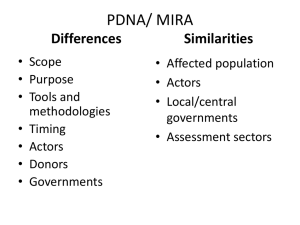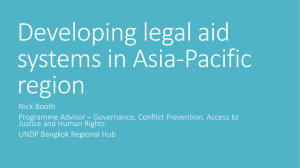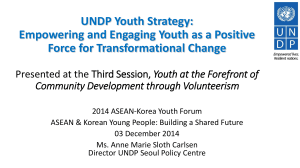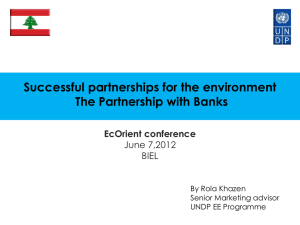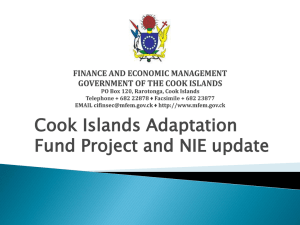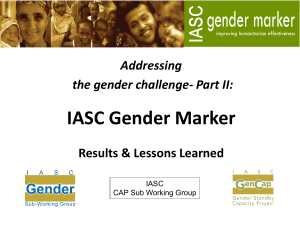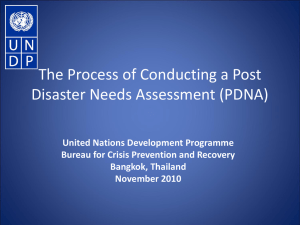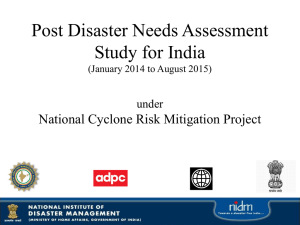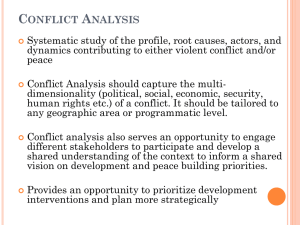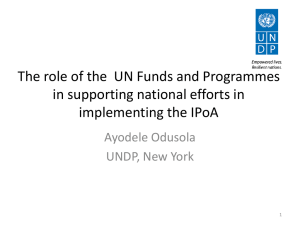REVIEW OF (country) PDNA Process
advertisement
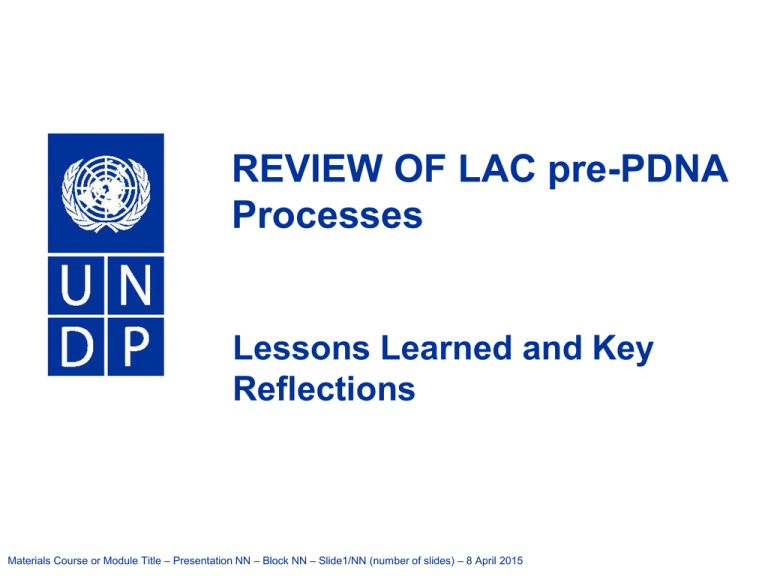
REVIEW OF LAC pre-PDNA Processes Lessons Learned and Key Reflections United Nations Development Programme Materials Course or Module Title – Presentation NN – Block NN – Slide1/NN (number of slides) – 8 April 2015 OVERVIEW • During the last decade more than 30 post-disaster recovery processes have been supported by BCPR in LAC. • Regarding the post-disaster assessments ant the relation with WB and ECLAC, we can group it in four stages: • First Stage (1998-2004): Indiference • Second Stage (2004-2006):Approaching: Do you want to dance with me? • Third Stage: (2006-2008): Distance: do we listen the same music? • Forth Stage: (2008-2010): Forced marriage: is this love? Materials Course or Module Title – Presentation NN – Block NN – Slide2/NN (number of slides) – 8 April 2015 First Stage (1998-2004): Indiference (1) • Major events: Hurricane Mitch (Nicaragua, El Salvador, Honduras, Nicaragua), Hurricane George (Haiti, Dominican Republic), Hurricane Isidore and Lili (Cuba), Venezuela floods and landslides, Peru earthquake, El Salvador earthquake, Bolivia floods, Bolivia landslide, etc. • UNDP assessment and programming strategies: Use of existing capacities in country offices to have presence in the affected areas and to orient key stakeholders in order to influence the agenda. Externals play a catalytic role. • Key examples: Deployment of UNV´s and project personnel to the affected areas, ad-hoc surveys, interviews with key stakeholders, national stakeholders consultation and reflection journeys: to facilitate consensual analysis, prioritization and commitment (Managua declaration) • Funding: First steps on the regular provision and use of TRAC 1.1.3. cat II ; management of OCHA cash grants and in-kind contribution. Materials Course or Module Title – Presentation NN – Block NN – Slide3/NN (number of slides) – 8 April 2015 First Stage (1998-2004): Indiference (2) • Results: Territorial assessments and UNDP projects (livelihoods, housing, local governance and DRR), national strategies and UNDP programs (DRR: ILS, capacity building), implementing partnerships with donors and NGO´s, reorientation of existing programs and development the new projects; institutional transformation and capacity development processes supported by UNDP. Incidence in policies. • Other stakeholders: Weak presence of OCHA and UNDAC teams, ECLAC assessments with the presence of other UN agencies (ELS), covered by UNDP (TRAC 113 cat II); WB deploys experts for vulnerability assessment and programming (based on infraestructure). Use of ECLAC assessments for reprogramation of credit tails, New WB loan window on DRR (collapse incipient institutions). IDB initiates plan Puebla-Panama. • Relations between stakeholders: make your own bussiness Materials Course or Module Title – Presentation NN – Block NN – Slide4/NN (number of slides) – 8 April 2015 Second Stage (2004-2006): Do you want to dance with me? (1) • Major events: Caribbean Hurricanes (Haiti, Dominican Republic, Granada, Jamaica, Cuba), Guyana floods, Bolivia floods, Vulcanic eruption Ecuador, etc. At global level: Pakistan earthquake, Tsunami, Kobe world summit. • UNDP assessment and programming strategies: Use of existing capacities in CO´s, inter-agency assessments and recovery frameworks, increased presence of externals that guide the intervention. CO´s playing a lead/coordination role for recovery. Regional roster and mechanisms for deployment • Key examples: Bolivia recovery framework, Granada recovery support, Ecuador recovery framework, DR programme, Cuba capacity building programme • Funding: TRAC 1.1.3. cat II totally established ; management of OCHA cash grants and in-kind contribution, increased funding from donors. Materials Course or Module Title – Presentation NN – Block NN – Slide5/NN (number of slides) – 8 April 2015 Second Stage (2004-2006): Do you want to dance with me? (2) • Results: Joint assessments Gov/Agencies SNU, recovery frameworks, UNDP projects (livelihoods, minor infraestructure, housing, local governance and DRR), Incidence in policies. • Other stakeholders: Increased presence of OCHA and UNDAC teams, participation in ECLAC assessments that continues covered by UNDP (TRAC 113 cat II); WB deploys experts for vulnerability assessment and programming (based on infraestructure). Use of ECLAC assessments for reprogramation of credit tails, UNDP and EC initiate partnership on DRR (DR project, Guyana, Cuba…).. • Relations between stakeholders: ECLAC is highly supported by UNDP in the Caribbean, training workshops for governments are covered, assessments and lessons learned exercises are funded. ECLAC utilizes UNDP materials and take all the credit (Ej: Guyana), UNDP capitalize on ECLAC (DR).UNDP incorporate HDR people to the ECLAC assessments to make it more relevant for the country, not credit is given (Guatemala), Materials Course or Module Title – Presentation NN – Block NN – Slide6/NN (number of slides) – 8 April 2015 Third Stage: (2006-2008) Distance: do we listen the same music? (1) • Major events: Bolivia floods, Guatemala and Mexico Floods, Uruguay Floods, Peru earhquake, Hurrican Felix Nicaragua, Surinam Floods, Haiti Floods, Dominican Republic Floods, Ecuador Floods. At global level: Humanitarian Reform, First steps of cluster system, CERF, PDNA rumor, BCPR change management process. • UNDP assessment and programming strategies: CO´s devoted to coordination and logistics for the externals, increased presence of specialists to coordinate, assess and programme, inclusion of projects in flash appeal and CERF to mobilize $ from humanitarian windows. Not clarity on UNDP role on response and recovery • Key examples: Peru Flash appeal and recovery process (no ECLAC), Tabasco and Chiapas (ECLAC, local presence), Nicaragua inter-agency assessment (no ECLAC), DR assessments and programme (divorced from ECLAC), Ecuador recovery assessment and programme (no ECLAC). Materials Course or Module Title – Presentation NN – Block NN – Slide7/NN (number of slides) – 8 April 2015 Third Stage: (2006-2008) Distance: do we listen the same music? (2) • Funding: TRAC 1.1.3. cat II and cat III increased, access to humanitarian windows. No bilateral resource mobilization channeled through UNDP. • Results: joint assessments with the SNU (Mexico, DR, Nicaragua) UNDP projectss (livelihoods, minor infraestructure, housing), Minor incidence in policies. • Other stakeholders: Increased presence of OCHA and UNDAC teams, ECLAC assessments cost-shared with IDB or WB or not covered by UNDP (except Mexico). • Relations between stakeholders: ECLAC is more agressively promoting themselves as lead agency for PDNA (name, letter to gov.), many RC are pissed off (Peru, Mexico). No relation with WB Materials Course or Module Title – Presentation NN – Block NN – Slide8/NN (number of slides) – 8 April 2015 Forth Stage: (2008-2010): Forced marriage: is this love? (1) • Major events: Costa Rica earthquake, Haiti floods, Cuba hurricanes, Haiti earthquake, El Salvador Floods, Chile earthquake. At global level: Cluster system, Reform, early recovery more established, EC/WB/UNDP agreement for PDNA, Surge teams, Ex Rep roster, PDNA first methodology. PDNA in Haiti (08-10), PDNA in El Salvador, PDNA transformed in DALA+ in Chile • UNDP assessment and programming strategies: CO´s continue focused on coordination and logistics for the externals, increased presence of specialists to coordinate, assess and programme, inclusion of projects in flash appeal and CERF to mobilize $ from humanitarian windows. UNDP role oriented to Early Recovery. Development of tools for ER: guidelines, UNDP ER policy, UNDP recovery assessment methodology (LAC region). No clear UNDP post-disaster identity at CO level Materials Course or Module Title – Presentation NN – Block NN – Slide9/NN (number of slides) – 8 April 2015 Forth Stage: (2008-2010): Forced marriage: is this love? (2) • Key examples: Cuba response and recovery plan led by OCHA, Haiti cash for work programme (local) and PDNAs (external) , Costa Rica Recovery framework led by government (no ECLAC), El Salvador PDNA, DR programme, • Funding: TRAC 1.1.3. cat II and cat III increased, access to humanitarian windows. No major bilateral resource mobilization. • Results: UN joint programme in Cuba and CR, CERF resources in Cuba, ELS, lack of overall strategy for UNDP, Minor incidence in policies. • Other stakeholders: OCHA and UNDAC teams completely established, strengthened partnership between ECLAC and the World Bank. • Relations between stakeholders: Forced marriage. Materials Course or Module Title – Presentation NN – Block NN – Slide10/NN (number of slides) – 8 April 2015 Conclusions • UNDP CO´s have been accumulating post-disaster experiences in the last decade but there is room for an strengthened CO´s position for recovery. The strategic approach has been decreasing for more fragmented intervention given the more centralized agenda and top-down approach.. • The Humanitarian Reform has increased the confusion about roles and responsabilities of the externals vis a vis the CO : do they come to support of to take over? (OCHA´s/ECLAC´s example) • How to ensure that PDNA´s will constitute a basis for the posterior CO´s work. Need to revise the corporate agreement and design strategies for a better capitalization at CO level. • Wider mandate, coordination functions, firewall with UN agencies: major disadvantage with strongly focused stakeholders as the WB. • Are we giving the rigth steps to build capacities to face recovery processes on a way that transform while repairs? (UNDP tools) Materials Course or Module Title – Presentation NN – Block NN – Slide11/NN (number of slides) – 8 April 2015 Lessons Learned 1. What worked? Effect of joint effort. 2. What didn’t work? Main constraints of joint approach. 3. What needs to be improved? What capacities are needed in govt? RCs?HCs, WB and EC counterparts? UN system? Others? 4. Was guidance provided by headquarters? Was it useful? Why/why not? 5. How much did your institution invest in the PDNA (financial, technical, logistical, resources)? 6. How much did counterparts invest in the PDNA (financial, technical, logistical, resources)? Materials Course or Module Title – Presentation NN – Block NN – Slide12/NN (number of slides) – 8 April 2015 Lessons Learned Cont. 7. Reflections on improving relationship between partner agencies, communications, logistics, decision making, etc. 8. Utility of the recovery framework? 9. What is the ability to monitor the recovery framework? 10. Sector specific lessons. 11. Have best practices been identified, institutionalized and shared? 12. Other major issues raised by PDNA process Materials Course or Module Title – Presentation NN – Block NN – Slide13/NN (number of slides) – 8 April 2015 Relationship of PDNA and the recovery process 1. What recovery strategies have been undertaken since the crisis? 2. How much has been invested in recovery? 3. Nature of relationship between assessments undertaken/PDNA recovery framework developed and actual strategies and investments? 4. Documentation of recovery activities: existence/effectiveness of monitoring system? 5. Do recovery needs persist that require further assessment and investment? Materials Course or Module Title – Presentation NN – Block NN – Slide14/NN (number of slides) – 8 April 2015
